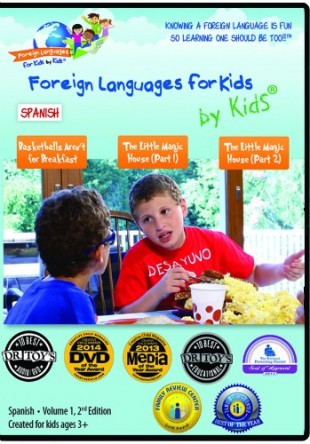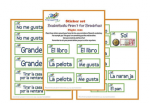
I have heard it said time and time again, “I don’t have time to teach a foreign language”. I said it myself! But, the truth of the matter is teaching a foreign language doesn’t have to be hard. In fact, you can teach a foreign language in 10 minutes a day!
How to Teach a Foreign Language in 10 Minutes a Day

Step 1:
Pop in one of our Foreign Languages for Kids DVDs. These DVDs are super simple and include the immersion approach. This means that the whole series is in Spanish. There is NO English involved. Watch 5 minutes of the video. As you are watching the video with the kids make a note of the words you recognize and what they mean.
Step 2:
Grab your copy of our Foreign Languages for Kids stickers and let the kids put stickers on items they learned in the video today.
Step 3:
As you go throughout your day use the Spanish terms you learned in day to day conversation. Encourage your kids to as well.
Step 4:
Repeat each day of the week!
A few tips to consider!
- I recommend watching the same clip at least twice before moving on to another. The more you and your children watch the videos they more you will remember what the words mean.
- On Fridays (or another day that suits you) watch all the clips you have learned so far in one sitting. Yes, this will be more than 10 minutes, but you can do that one day a week, right?
- Our DVD’s can be watched during breakfast, before quiet time, after dinner or any time of the day. You really only need 10 minutes a day to start teaching a foreign language to your kids!
- If you want more, consider enrolling in our online membership course. This course not only allows you to access our DVD’s but also includes games, quizzes, flashcards and more!
How does our program teach a foreign language in only 10 minutes a day?
- The Video Series incorporates a teaching style that creator Kit Strauss developed over a decade with her own children. It combines immersion with visuals – adding a good dose of humor and fun.
- Painful memorization is not useful or fun. Our program does not require rote memorization. When learning is fun it is easier for students to retain what they learned.
- Immersion is KEY to learning a foreign language. In order for a student to learn a foreign language, they must have to use it in a meaningful, real-world way. Our videos are spoken ALL in Spanish. They children in the videos are going throughout their daily activities. This IS a real world approach. They are using words OUR kid’s will and do use on a daily basis. This is more relatable to children than the more common teaching methods like rote vocabulary memorization.
- With Foreign Languages for Kids, your family will be learning Spanish TOGETHER. That means those words you picked up on in that five-minute video clip will be known by each child in the family and YOU. So, when your child comes up to you and says “grande” you will know what they are talking about. When your child asks a sibling for a libro he will know what he means because they are learning the words together.
Because of this, our program requires little time each day. Can you spend more time learning Spanish with our program? Of course! We have teachers guides that include daily lesson plans, additional activities, and much more, and we’d love for you to use those resources!
But, starting out, if you don’t want to make that commitment we understand. You and your family can STILL learn Spanish in as little as 10 minutes a day. So, what are you waiting for? Order Foreign Languages for Kids today!
Misty Bailey is a work at home homeschool mom. She loves helping new homeschoolers and has a Homeschool 101 eBook for those getting started. She shares everyday tips and encouragement for the homeschool mom on her blog Joy in the Journey.






